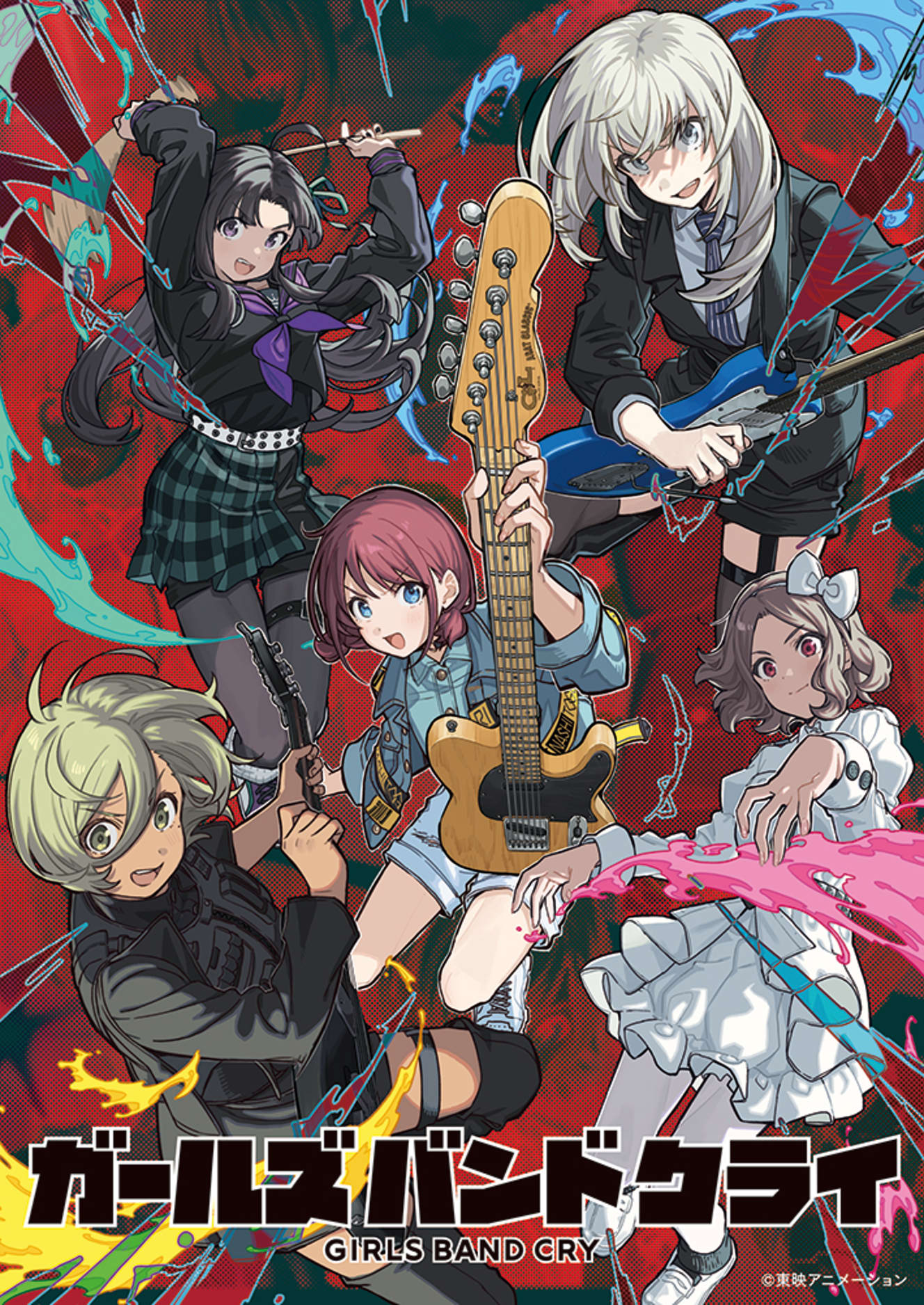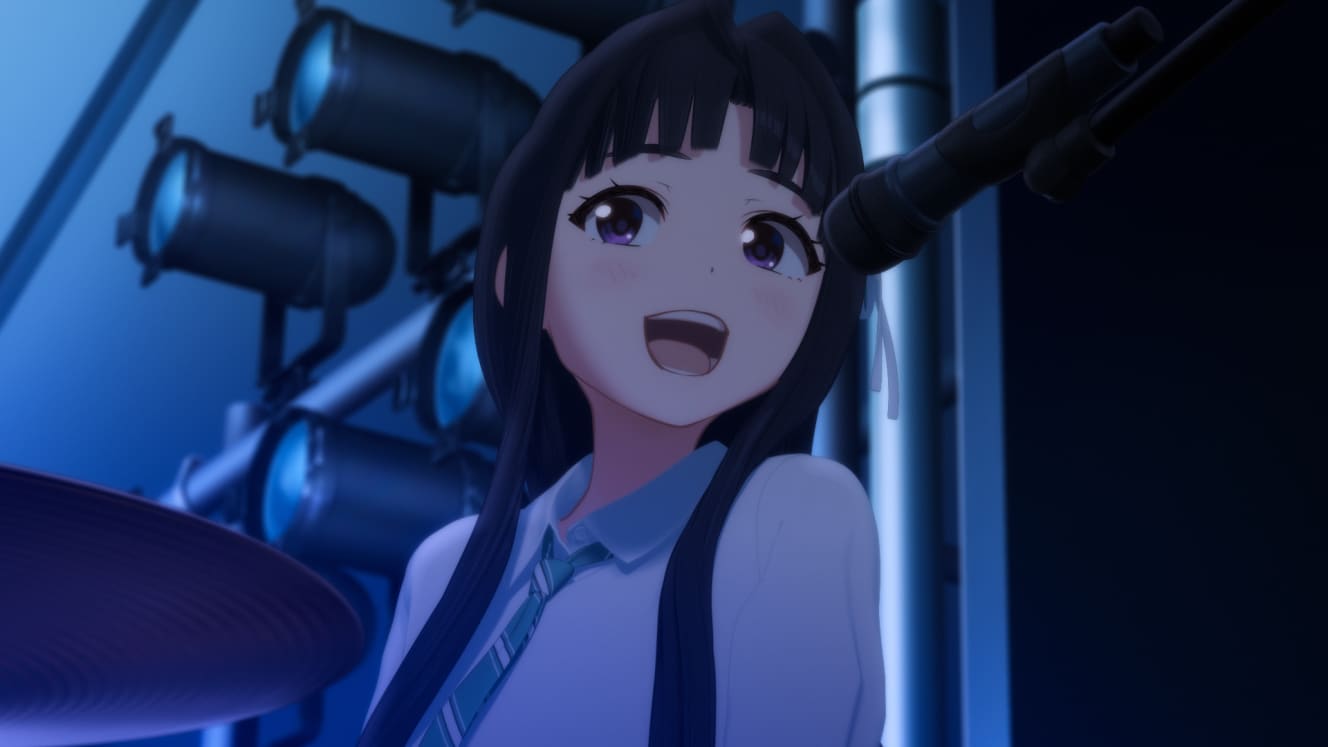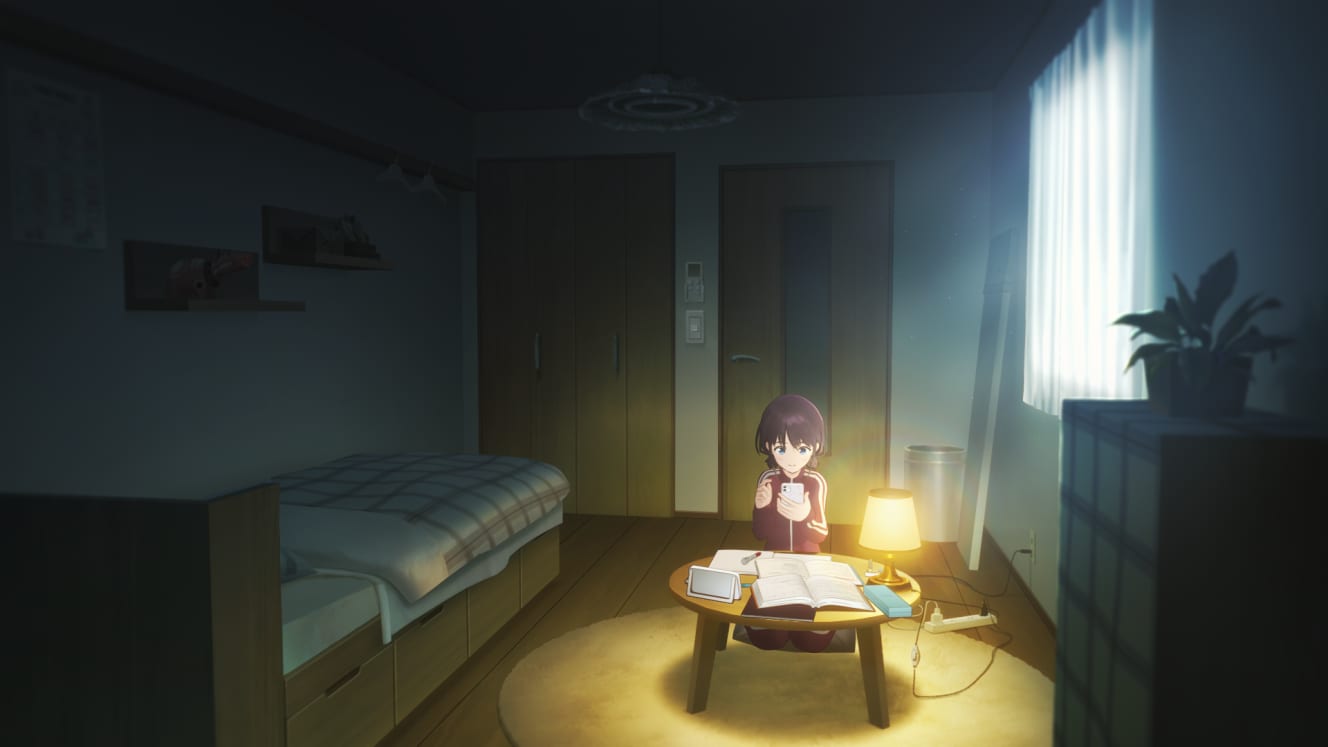Skilled Band Girls Challenge Themselves as Voice Actors in Anime ‘Girls Band Cry’

Girls Band Cry is a girls’ rock anime themed around music and youth. It aired on terrestrial TV channels such as TOKYO MX from April to June 2024, and is currently being streamed on various platforms like Amazon and ABEMA.
The anime was unique in its approach: “an original work without a source material,” “casting new voice actors for main characters,” “voice actors who are former skilled band girls performing the in-show music,” and “illustration-style 3D animation.” These unfamiliar methods, coupled with the adventurous elements and the competitive season overlapping with popular adaptations and trending works, meant that it received little attention before its broadcast.
However, right after the first episode aired, its popularity exploded. The views of the official music video surged, and the YouTube views of “Hazete Saku,” which was released before the TV anime broadcast, surpassed 12.5 million. The Blu-ray & DVD sales competed for the top spot among spring 2024 anime, showcasing the work’s “dominant anime” aura. The project was spearheaded and advanced by Toei Animation producer Tadashi Hirayama. In the current Reiwa era, we asked Mr. Hirayama about what Girls Band Cry aimed to depict and the future of the story.

――Please tell us about your background.
“I’ve always loved anime and entered this world because of that. The work that inspired me to decide to enter this field was Patlabor 2: The Movie. I saw that such political fiction could be done in anime, and I wanted to create such works and become an anime director. With that dream, I joined Madhouse. While learning various things from director Gisaburo Sugii, I came to realize that I didn’t have a talent for directing [laughs], so I decided to move into producing.”
――Director Sugii is a legend in the anime world, having been active since Astro Boy. What are some of your works as a producer?
“After moving from Madhouse to Sunrise, I produced various works, but the one most people are familiar with is the idol anime Love Live!. In 2019, I moved from Sunrise to Toei Animation and began working on the production of Girls Band Cry.”
――Girls Band Cry started airing in spring 2024, so it took five years from its inception. What was the reason for the long duration of the project?
“In Girls Band Cry, we took on the challenge of creating ‘illustration-look 3D animation,’ where we animate illustrator Nari Teshima’s character designs exactly as they are in 3D. The main reason for the long duration was the significant amount of time required for developing this technology. We went through a lot of trial and error, and before we knew it, five years had passed.”
――Given that the development period was extended, I imagine the budget increased significantly. Was it financially manageable?
“The budget did become quite large. However, thanks to the tremendous support from our customers, it looks like we will manage. That was a huge relief.”
――Were there any crises that nearly led to the project’s cancellation?
“There were several. The lack of benchmark works made tasks related to the script difficult. The absence of benchmark works also meant we struggled to overcome technical challenges. We had to tackle various problems that arose due to the increasing budget as the schedule was delayed, resolving them one by one each day.”
――Looking back now, considering the 3DCG visuals that users were not yet accustomed to, the challenge of young band girls taking on voice acting, and the fact that it was an original work with no source material, it seems like an audacious plan. How did it all start?
“I initially reached out to director Kazuo Sakai and scriptwriter Jukki Hanada, with whom I had previously collaborated on the ‘Love Live!’ series, and we began brainstorming. At that time, our initial idea was to create a music-themed work. We had experience working on music-centered projects, and we thought we could leverage that as our strength. During our discussions, Hanada suggested, ‘How about a story about moving to Tokyo?’ When I received the first draft of the script for the first episode, I strongly felt that this was something unprecedented and that we should bring it to life.”
――The five main characters of the girl band “Togenashi Togeari” are: the perspective character Nina Iseri, who meets and significantly changes the fate of the others; Momoka Kawaragi, who encounters Nina; Subaru Awa, the beautifully skilled and socially adept balancer; Tomo Ebizuka, a genius girl who joins later and is a year younger than Nina; and Rupa, the calm yet sharp-tongued oldest member of mixed South Asian descent, who is extremely popular. Why were these five characters chosen?
“We decided on five characters quite early on. Considering we wanted to create a work that would appeal to current anime fans, we focused on the Vocaloid culture, which is familiar to that demographic. The typical band lineup used in Vocaloid culture includes vocals, guitar, drums, keyboard, and bass, so we needed five members to fit that structure.”
――One of the characters, Rupa, is a popular figure with a gentle demeanor but also a radical side. She is of South Asian descent. In previous anime, foreign characters have typically been Western. Why did you choose this approach?
“In today’s Japan, it’s quite common to encounter people of foreign origin due to tourism, immigration, and labor. It would actually be unusual for all five characters to be Japanese. When considering who works in Japan today, there are many from Asia. So, we decided to reflect that in the character of Rupa.
Rupa represents the real Kawasaki as it is now. Currently, nearly 10% of the population in Kawasaki’s waterfront area is of foreign origin. Given that Kawasaki is the setting, it was essential to include this aspect. We also wanted to depict her daily experiences accurately. For example, in episode 8, there’s a scene where Rupa, working part-time at a beef bowl shop, is reprimanded by a salaryman for being a foreigner. The salaryman isn’t portrayed as a villain; such interactions are part of daily life. We aimed to create a grounded story that doesn’t shy away from these everyday realities.”

――After Rupa, who was subjected to unjust words from a customer, sends them off with a smile, the scene where she tells Nina, who is worried about her, “It means I need rock too,” is quite symbolic and impactful for the work.
“Everyone carries their own burdens. And I believe the viewers share this experience as well.”
――In the series, “Togenashi Togeari,” the members chosen through auditions are not only voice acting for their characters but also actively participating in real band activities. The band’s album was released prior to the airing of the show, and the official MV was posted on YouTube about a year before the broadcast. What was the reason for taking so much time to establish a genuine band?
“Since it’s a music anime, I thought that for the visuals to be convincing, there needed to be a real, solid band as the background. By creating genuine music, we aimed to give the visuals credibility to people who are passionate about music and have a high sensitivity to it.”
――The single released before the main broadcast includes a voice drama depicting the characters’ daily lives. What was the reason behind this?
“For example, it’s fun to have episodes like these that show everyday life. This is to provide a broader range of enjoyment for the audience. Since the main series has a tense storyline, we wanted to offer a more relaxed and enjoyable side of the characters as well. Some of the early MVs did not feature the characters from ‘Girls Band Cry,’ as we initially aimed to appeal to a wider audience through the music aspect. The MVs were viewed by about 60% of people from abroad. I think our attempt to have multiple entry points and attract a large audience was somewhat successful.”
――What was the reason for insisting on an illustration-look 3DCG animation?
“Hand-drawn animation had reached its technical ceiling, and it was becoming apparent that the future would involve a contest of financial power. On the other hand, there was still a lot of potential in CG animation. I thought that we needed to do something that could only be done in Japan and show the world what Japanese CG animation is capable of, thus paving the way for future development. To do that properly, research and development were necessary. I had a sense that it would be a challenging path, and it certainly was.”
――Why was there such a strong emphasis on 3DCG?
“In 2018, the release of the 3DCG film ‘Spider-Man: Into the Spider-Verse’ from the US was significant. It was shocking, and I thought, ‘If such things are being done abroad, what will become of Japanese animation?’ We needed to create something even more amazing and stay ahead. ‘Spider-Man: Into the Spider-Verse’ had an outstanding script, and I analyzed it because it was not only fascinating as a story but also visually unprecedented. Moreover, it wasn’t just appreciated by enthusiasts; it was a global hit, which was significant. It was as if Americans had thoroughly digested the look of Japanese hand-drawn works, reimagined it into a new, appealing look, and presented it as remarkable entertainment. We needed to think of a way to compete with that.”
――So that is what you mean by “illustration-look 3DCG animation”?
“Yes. For ‘Girls Band Cry,’ our approach was to take the popular illustrations by Nari Teshima and animate them as they are. This is a concept that no other country has tried, and it’s an idea that could only be realized in Japan. If this approach becomes a hit and establishes itself as a methodology, it would take other countries several years to catch up even if they tried. Given the popularity of V-Tubers, I thought that 3DCG characters with a non-hand-drawn look might also be well-received.”
――Gathering famous voice actors to attract fans is a well-known marketing strategy. Why did you choose not to do that?
“I’ve always believed that if something is interesting, people will watch it, and in reality, if it’s interesting, people will watch it. So, I decided to trust in the strength of the work itself.”
――For the members of “Togenashi Togeari,” was there a greater emphasis on being a “band member” or being a “voice actor”?
“Being a band member. People who are serious about music have good ears, so I had the expectation that they would quickly become proficient in voice acting as well, and in reality, they became very skilled.”
――Mirei, who plays Subaru Awa, improved rapidly since her debut in episode 2. Her performance during the voice test in episode 11 is captivating and could be listened to continuously.
“Yes, Mirei improved remarkably quickly.”

――As a producer, what was something you absolutely wanted to include in the work?
“I personally wanted to push for the entire project. If I had to specify, I wanted to see Hanada-san’s script visualized under Director Sakai at Toei Animation. Hanada-san’s script is rich in detail and requires a high level of realism, which demands considerable skill from the storyboard artists. Director Sakai is capable of that. His storyboards also demand high skills from the animators, and the CG animators at Toei Animation were up to that challenge. It was my job to ensure that this was all completed by the broadcast.”
――The role of a producer often involves significant relationship management. In “Girls Band Cry,” the cooperation with various shops and facilities in Kawasaki City, the main setting, was exceptionally well-managed, creating a strong local engagement.
“That was the result of the studio’s dedicated efforts, including mine (laughs). We made phone calls, explained what the anime was about, and how we wanted to use their locations in specific scenes. If they agreed, we visited the shops, took photos, and built up from there. Most people found it interesting when we explained, and it rarely resulted in a rejection. We aimed to make everyone involved happy and create a Win-Win situation.”
――Why did you choose Kawasaki as the setting? Why did the protagonist, Nina, who comes to Tokyo from Kumamoto, end up choosing this city? Were there other candidates?
“Initially, I thought places like Yokohama might be interesting, but it felt a bit too stylish for this story (laughs). Then I considered the 23 wards of Tokyo. However, if you’re depicting a young girl coming to Tokyo and struggling with poverty while trying to make it with a band, the high rent in the 23 wards makes it unrealistic. That’s when the idea of Kawasaki, next to Yokohama, came up. During the location scouting, we saw a banner saying ‘Music City Kawasaki’ right outside the station, and there were music stores and live houses. It was clear there was a music scene there. Also, when we checked the rent, it was quite affordable.”
――How much is the rent for Nina’s apartment in the show?
“Based on our scouting in 2020, it was around 50,000 yen. Given the rising cost of living, it might not be that amount now. At that time, there were properties available in the 30,000 yen range that seemed suitable for Nina, so we thought it would work.”

The attempt to depict the current reality of the Reiwa era in a challenging and experimental way, and to create a grounded story, gradually took shape and quickly gained passionate popularity after its broadcast.
In the second part of the interview, we will focus on what happened once the show started airing, exploring the finer details of the story, key points, and the buzzworthy final episode.
Confession from the Mastermind Behind ‘Girls Band Cry’ Addresses Doubts About That Scene and Answers in Episode 13
Profile: Tadashi Hirayama
Tadashi Hirayama graduated from the University of Tokyo and joined Madhouse in 1999, moving to Sunrise in 2000. As a producer, he has been behind hit works such as Love Live!, Love Live! Sunshine!!, and Horizon’s Edge. Since 2019, he has been with Toei Animation, where he is responsible for producing Girls Band Cry.
Interview and Text by: Miyu Kurusu
Miyu Kurusu is a freelance writer specializing in humanities, social issues, and subculture. She writes articles for various media, including magazines, newspapers, and online platforms. She has authored numerous books.
X ID: @mewzou
Girls Band Cry
Available for unlimited streaming on Amazon Prime Video, ABEMA, BANDAI CHANNEL, Hulu, and U-NEXT
Official website: https://girls-band-cry.com/
Official X: https://x.com/girlsbandcry
Photo: ©️ Toei Animation